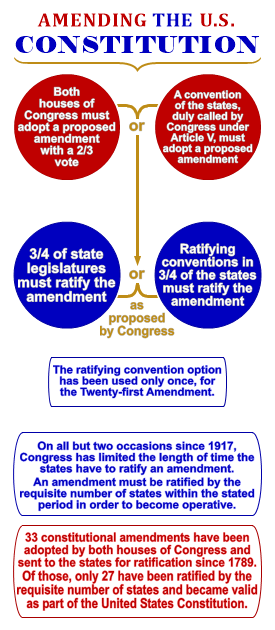Convention to propose amendments to the United States Constitution
Convention to propose amendments to the United States Constitution is a procedure outlined in Article V of the United States Constitution that allows for the Constitution to be amended. This process is one of two methods mentioned in the Constitution for proposing amendments, the other being through a two-thirds majority vote in both houses of Congress. The convention method allows for amendments to be proposed upon the application of the legislatures of two-thirds (currently 34) of the states.
Background[edit | edit source]
The Founding Fathers of the United States included the convention method as a means to ensure that the states retained a mechanism to propose amendments to the Constitution without needing the approval of Congress. This was seen as a way to balance the power between the federal government and the states and to provide a method for reform or changes if the federal government became unresponsive to the needs or concerns of the states.
Process[edit | edit source]
The process for a convention to propose amendments involves several steps:
- Two-thirds of the state legislatures (34 out of 50) must pass resolutions calling for a convention to propose amendments to the Constitution.
- Once the threshold of 34 states is reached, Congress is required to call a convention for proposing amendments.
- Delegates to the convention would then meet to consider and propose amendments. The specifics of how delegates are chosen are not detailed in the Constitution and could vary.
- Any amendments proposed by the convention must be ratified by three-fourths (currently 38) of the states, either by their legislatures or by state ratifying conventions, to become part of the Constitution.
Debate and Uncertainties[edit | edit source]
The convention method has never been successfully used to amend the Constitution, and there are many uncertainties and debates surrounding the process. Key issues include:
- The lack of detailed procedural guidelines in the Constitution, leading to questions about how a convention would be convened, how delegates would be selected, and how the convention would operate.
- Concerns about a "runaway convention," where delegates could propose sweeping changes to the Constitution beyond the scope of what was initially intended by the states calling for the convention.
- The debate over whether states can limit the scope of a convention to specific topics or whether the convention would have broad authority to propose any amendments.
Historical Attempts[edit | edit source]
Throughout American history, there have been numerous attempts to initiate a convention to propose amendments, often driven by specific issues such as campaign finance reform, balanced budget amendments, or term limits for Congress. However, none of these efforts have reached the threshold of 34 states needed to call a convention.
Conclusion[edit | edit source]
The convention to propose amendments is a constitutional mechanism that reflects the principle of federalism and the desire of the Founding Fathers to provide a means for states to address concerns with the federal government. While it has never been used, the possibility of a convention remains a topic of interest and debate among scholars, politicians, and activists.
Search WikiMD
Ad.Tired of being Overweight? Try W8MD's physician weight loss program.
Semaglutide (Ozempic / Wegovy and Tirzepatide (Mounjaro / Zepbound) available.
Advertise on WikiMD
|
WikiMD's Wellness Encyclopedia |
| Let Food Be Thy Medicine Medicine Thy Food - Hippocrates |
Translate this page: - East Asian
中文,
日本,
한국어,
South Asian
हिन्दी,
தமிழ்,
తెలుగు,
Urdu,
ಕನ್ನಡ,
Southeast Asian
Indonesian,
Vietnamese,
Thai,
မြန်မာဘာသာ,
বাংলা
European
español,
Deutsch,
français,
Greek,
português do Brasil,
polski,
română,
русский,
Nederlands,
norsk,
svenska,
suomi,
Italian
Middle Eastern & African
عربى,
Turkish,
Persian,
Hebrew,
Afrikaans,
isiZulu,
Kiswahili,
Other
Bulgarian,
Hungarian,
Czech,
Swedish,
മലയാളം,
मराठी,
ਪੰਜਾਬੀ,
ગુજરાતી,
Portuguese,
Ukrainian
Medical Disclaimer: WikiMD is not a substitute for professional medical advice. The information on WikiMD is provided as an information resource only, may be incorrect, outdated or misleading, and is not to be used or relied on for any diagnostic or treatment purposes. Please consult your health care provider before making any healthcare decisions or for guidance about a specific medical condition. WikiMD expressly disclaims responsibility, and shall have no liability, for any damages, loss, injury, or liability whatsoever suffered as a result of your reliance on the information contained in this site. By visiting this site you agree to the foregoing terms and conditions, which may from time to time be changed or supplemented by WikiMD. If you do not agree to the foregoing terms and conditions, you should not enter or use this site. See full disclaimer.
Credits:Most images are courtesy of Wikimedia commons, and templates, categories Wikipedia, licensed under CC BY SA or similar.
Contributors: Prab R. Tumpati, MD





